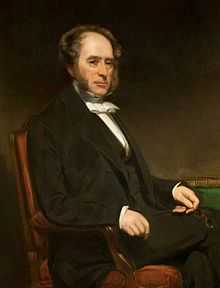James Begbie

James Begbie FRSE FRCPE FRCSE (October 1798, Edinburgh – 26 August 1869, Edinburgh) was a Scottish medical doctor who served as president of the Medico-Chirurgical Society of Edinburgh (1850–2) and as president of the Royal College of Physicians of Edinburgh (1854–6).
He was among the first physicians to give a detailed description of exophthalmic goitre, currently known as Graves disease (previously called Basedow's syndrome or Begbie's disease). He is also related to the study of Dubini's disease, the old name for myoclonic epidemic encephalitis.[1]
His son James Warburton Begbie was also an eminent physician.
Biography
Begbie was born in Edinburgh, and educated at the High School and Edinburgh University (MD 1821).[2] One of his instructors was John Abercrombie (1780–1844). Later on, he also became Abercrombie's assistant.[1]
In 1821, Begbie obtained his medical doctorate from the University of Edinburgh. In 1822, he became a fellow of the Royal College of Surgeons. In 1827 he is listed as a Governor of the Dean Orphan Hospital[3]
In 1847, he also became a fellow of the Royal College of Physicians, and became its president from 1854 up to 1856. For forty years, Begbie was a physician for the Scottish Widow’s Fund and Life Assurance Society.[1]
Begbie died in Edinburgh and was interred at the New Calton Cemetery.[1]
Works
Begbie wrote about important statistical data, the use of arsenic for chronic rheumatism, the use of nitric-hydrochloric acid for oxaluria, and the use of potassium bromide for nervousness.[1]
Family
Begbie's son was Dr James Warburton Begbie FRSE (1826-1876).[4]
References
- ↑ 1.0 1.1 1.2 1.3 1.4 James Begbie, WhoNamedIt.com.
- ↑ Waterston, Charles D; Macmillan Shearer, A (July 2006). Former Fellows of the Royal Society of Edinburgh 1783–2002: Biographical Index (PDF) I. Edinburgh: The Royal Society of Edinburgh. ISBN 978-0-902198-84-5. Retrieved 27 December 2010.
- ↑ https://books.google.co.uk/books?id=ulBGAAAAYAAJ&pg=PA56&lpg=PA56&dq=William+Beilby+dr&source=bl&ots=BDOBAsKmwN&sig=rsmdDthe5F-eOrKZ1afGKnQ-_N4&hl=en&sa=X&ei=r-M4VaqkMZLUavv2gZgG&ved=0CCgQ6AEwATgK#v=onepage&q=William%20Beilby%20dr&f=false
- ↑ http://www.royalsoced.org.uk/cms/files/fellows/biographical_index/fells_indexp1.pdf
|